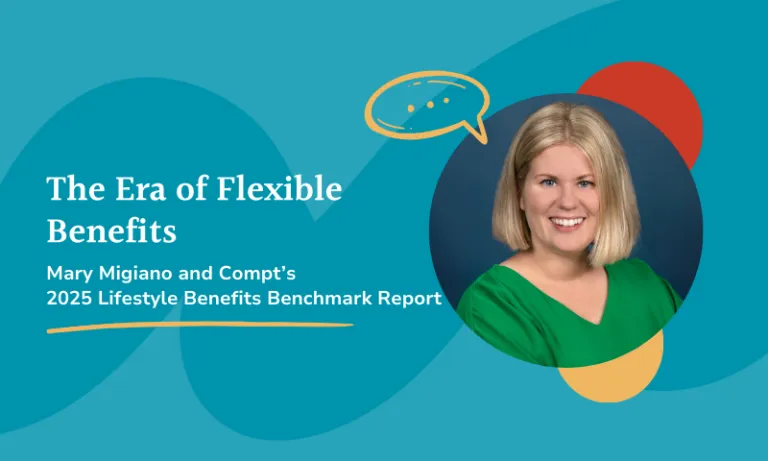Your employees’ mental health is just as important as their physical health. However, not every health insurance plan covers mental health. A stipend program is a simple and low-cost way to support them.
According to MindShare Partners, 84% of workers say their job or workplace conditions have contributed to at least one mental health challenge. Most (92%) agree that working for an employer who values their emotional and psychological well-being is paramount.
When something is important to your employees, it should be important to you. Prioritizing employee health and well-being leads to a happier and more productive workforce, lower turnover and absenteeism rates, and better overall employee satisfaction.
The most straightforward way to do that? A mental health stipend.
Here’s what we’ll cover in this guide:
- What is a mental health stipend?
- How a mental wellness stipend works
- Reasons to offer mental wellness stipend benefits
- How employers can set up a mental health stipend program
Invest in employee well-being with a mental health stipend
(Compt customers see 94% engagement rates!)
What is a Mental Health Stipend?
First, a definition:
A mental health stipend is a fixed amount of money an employer gives to their employees for mental wellness services and activities.
You might also hear them called:
- Mental wellness accounts
- Mental health and wellness stipends
- Mental wellness allowances
While most companies offer monthly wellness stipends for mental health, some issue them as an annual or quarterly lump sum. Employees can use this money for anything related to mental health care, including therapy sessions, mental health services, meditation apps, yoga classes, and self-care activities.
How Mental Wellness Stipends Work
Before we talk about how a mental health stipend works, it’s important to cover some nuances within the lifestyle benefits industry.
Stipends are the umbrella term for employer-sponsored funds provided to employees to spend on predefined categories.
In this case, a mental health stipend is a specific category companies select for which employees can spend. Or an organization prefers, they can design them into a larger category, like a wellness stipend, which covers mental health along with other wellness related activities.
A stipend program is the overarching structure, but how employees access and use that money can vary. There are three methods of delivery for stipends including reimbursements, marketplaces, and debit cards. For the purposes of this piece, we’ll be focusing on reimbursements as they are preferential to HR and Finance leaders as it is widely considered the most reliable and IRS-compliant way to offer stipends.
With the reimbursement model, employees pay upfront for eligible expenses, submit receipts or proof of spend, and are then reimbursed by the company. This process ensures employees are reimbursed after submitting proof of spend (like a receipt or invoice), and thus companies can apply tax treatment correctly at the time of reimbursement and always have a clear audit trail on hand. This model offers flexibility to employees — allowing them to choose what they want — while ensuring the company stays in control of eligible use, compliance, and budget.
Here’s how a typical wellness stipend program works (as an employer):
- You set aside a specific amount of money for each employee’s wellness-related expenses.
- You’ll create a list of approved services/activities and set eligibility requirements.
- Each month, you release the stipend amount through payroll.
- Depending on an approved service or activity, employees choose how and when to use their stipend.
According to our Annual Benchmark Report, companies offer between $180 to $3,000 annually for a general health and wellness stipend. However, with Comp, companies can design these as a semi-annually, quarterly or monthly stipend too.
What Expenses Do They Cover?
Mental wellness programs can be customized by the employer, but expenses fall under the broader goal of supporting emotional well-being, stress management, therapy access, and mental wellness. The best way to promote employee well-being is to make yours as flexible and accommodating as possible.
Here’s a list of some commonly covered services and activities:
- Mental health assessments or screenings
- Nutrition counseling related to mental health
- Therapy sessions (in-person and virtual)
- Supplements
- Telehealth services
- Life coaching
- Crisis helplines
- Mindfulness and meditation apps (e.g. Calm, Headspace, Insight Timer)
- Mental health workshops and classes
- Mental health books or workbooks (e.g. anxiety, trauma, mindfulness, burnout)
- Stress management programs
- Sound baths or healing sessions
- Stress relief programs (like MBSR)
- Personal training with a mental health emphasis
- Journals or guided mental health workbooks
- Environmental improvements (e.g. weighted blankets, light therapy lamp (for Seasonal Affect Disorder), white noise machines or sleep sound devices)
Since mental health is closely linked to physical, emotional, and financial wellness, some companies allow employees to use their stipends for expenses such as gym memberships, fitness classes, nutrition classes, or financial counseling services.
Benefits of Offering Mental Health Stipends
Improves access to mental health resources
According to research from Amwell, more than half of employees either don’t have access to mental health benefits or aren’t sure if they do. 85% of those with access through their health plans don’t use them. Roughly two-thirds say they’d use digital resources if they could access them through their employers.
Additional research shows that 42% of Americans who needed care in the last 12 months didn’t receive it due to costs and other barriers.
The issue here is access. Health insurance coverage is notoriously complicated and often leaves employees feeling unsure of what they have access to. Providing a mental health stipend makes it easy for employees to access exactly the resources they need without worrying about what’s in their network.
Higher employee engagement and productivity
The primary reason companies choose to offer stipends? To support their employees’ mental health and well-being.
And what comes along with that? A happier, healthier, and more engaged workforce.
A 2022 study from MetLife found holistically healthy employees are 79% likelier to show job satisfaction, 59% likelier to feel engaged at work, and 53% likelier to be productive.
Lower rates of absenteeism and turnover
According to the American Psychological Association’s 2023 Work in America survey, nearly all (92%) employees say it is important to work for an organization supporting their mental health.
In addition to the clear connection between poor mental well-being and declining engagement/job performance, absenteeism and turnover are tangible (costly) impacts that follow shortly afterward.
In the short term, these employees take more time off for mental health issues or related physical symptoms. Long-term, they’ll find an employer that supports their needs.
Long-term cost savings
We don’t blame you if you don’t see mental health stipends as a way to save money. But there’s more to it than money coming out of your pocket. You have to consider the costs of not supporting your employees’ mental and emotional health.
On average, absenteeism costs employers $3,600 per hourly worker and $2,660 per salaried employee yearly. Turnover can cost 6 to 9 months of an employee’s salary.
With a mental health stipend program, you can increase retention and engagement rates by a couple of hundred dollars per month per employee (at most). By extension, you’ll reduce the abovementioned costs. So, really, it’s more of an investment than an expense.
How Companies Implement Them
You can offer a mental health stipend as a standalone payment, reimbursement hybrid model, or part of a larger employee wellness program.
- A standalone mental wellness stipend — Each timeframe, you’ll provide a fixed allowance to allow employees to manage their own mental wellness expenses. You may limit what employees can use it for, or you can say, “Anything that supports your mental health!”
- A wellness stipend — You might choose to offer a general wellness stipend to support a wider range of wellbeing activities, giving your people the flexibility to choose the kind of support they need most — whether that’s mental health, physical fitness, stress relief, or something else entirely.
- A Lifestyle Spending Account (LSA) — If you want to support an even broader range of employee needs — including those that may be impacting their mental health, like rising grocery costs, eldercare responsibilities, or student loan debt — a Lifestyle Spending Account (LSA) might be the best way to go. LSAs allow you to offer multiple categories of support at once, from wellness and family care to food, or professional development, giving employees the flexibility to use their stipend where it matters most and without increasing budget.
Psst: Learn how about how to design a successful health and wellness stipend programs in our blog post.
Tax Implications of Wellness Stipends
Most common wellness stipend expenses — like gym memberships, meditation apps, massage therapy, fitness equipment, or nutrition counseling — are considered a taxable fringe benefit by the IRS in most cases because they are personal in nature and therefore taxable income to the employee.
Addressing the tax implications from the onset of a program is paramount because when companies fail to withhold taxes, it may trigger issues during an IRS audit — and either the company or employee could be on the hook for back taxes and penalties.
Some vendors (like Compt!) automatically track and tag taxable (and non-taxable items) for you, making compliance easier and reducing the risk of end-of-year surprises.
To stay compliant, companies typically do one of the following:
Option 1: Employees cover the cost of taxes
This is the most common and compliant approach. The stipend is added to the employee’s paycheck as taxable income, and payroll taxes are withheld just like with regular earnings. The employee receives the post-tax amount in their paycheck.
Option 2: Employers gross up the stipend
Some companies choose to increase the stipend amount to help offset the tax burden. The employee still sees the stipend in their paycheck, and taxes are still withheld. However, the employer adds extra funds to ensure the employee receives the full intended amount (e.g., $130 grossed up to net $100). Before doing this, be aware that this means it is a higher cost to the employer and requires some tax calculations.
Any amount your employees forfeit from their stipend, WSA, or LSA is not taxable. For example, if you offer $100/month ($1,200/year) but an employee uses only nine months of it, they’ll only owe taxes on the $900 they used.
Leading Companies Offering Mental Health & Wellness Stipends
We aren’t just recommending mental health stipends because we sell stipend software. For the nation’s best employers, supporting employee mental well-being is high on the agenda. Here are just a handful of examples:
- Atlassian offers employees an annual stipend reimbursement for mental health expenses among its extensive wellness program.
- Basecamp offers employees $100 monthly toward mental health expenses, including therapy sessions and meditation apps.
- Palo Alto Networks offers employees $250 every quarter exclusively for their health and well-being.
- Peloton offers $500 per year in reimbursements for wellness initiatives.
- The Zebra gives employees $100/month to put toward their mental and physical health needs.
- Salesforce employees have $100 monthly to use for anything health and wellness-related.
- Nextdoor uses Compt to offer health and wellness stipends, which many employees use to cover mental health expenses.
- Zoom has a unique wellness reimbursement program that includes mental health care.
Building Stipends into Your Wellness Program
One employer’s wellness programs will always differ from the next. How exactly you choose to promote your employees’ mental and physical wellness will depend on your team’s unique needs and interests.
But thanks to the versatility of stipends, you have a lot of room to get creative.
Here’s a step-by-step guide to help you get started creating a mental health stipend:
1. Pinpoint your employees’ needs
Before implementing any employee benefit, ensure it aligns with your employees’ needs. Otherwise, it will be less impactful.You can better understand your employees’ needs through employee benefits surveys, focus groups, and one-on-one meetings.
Ask them what types of resources they would find most helpful for managing their mental and physical health.
2. Consider different stipend options
Once you have a good idea of what your employees need, consider which type(s) of stipends make sense for your company and budget.
You have three main options:
- A dedicated mental health stipend to cover therapy sessions or medication costs.
- A general wellness stipend that employees can use on anything health and wellness-related, including mental health expenses.
- A Lifestyle Spending Account (LSA) that can cover a wider range of spending categories, including mental health expenses.
How you offer this benefit depends on your current company-sponsored mental health resources.
A general wellness stipend is enough if you already provide access to services like telehealth counseling, meditation app subscriptions, and corporate gym memberships. If you don’t offer these benefits and your employees express significant interest, you’ll want to address it head-on with a dedicated stipend.
3. Decide how much to offer
Next, you’ll need to consider how much you can realistically allocate to these stipends each month or quarter.
Most employers offer somewhere between $50 and $250. Any lower than that, and it isn’t useful. If any higher, most employees won’t take full advantage.
4. Set eligibility requirements
You may or may not have a larger health and wellness program. Stipends are great because they have fewer strings attached and are easy to offer.
Because of their flexibility, you can offer them to more of your valued team members.
In addition to your full-time salaried workers, you might extend a small stipend to:
- Summer interns
- Part-time workers
- Contractors working 30+ hours per week
5. Benchmark against your competitors and the job market.
Ultimately, your ability to compete in the talent market depends on how your health and wellness benefits stack up against other employers’.
Start by researching the benefits your industry competitors offer. Then, broaden your scope to include companies outside your industry that are similar in size, location, and employee demographics.
For more, check out our guide to creating an employee benefits benchmarking report.
6. Make it EASY!
Perhaps most importantly, your wellness stipend program must be easy to understand and execute. Otherwise, it will create back-office headache, and nobody will enroll.
Stipend software is the starting point for an integrated approach. You can use it to:
- Automate creating and distributing stipends
- Track how much each employee has spent and how much they have remaining
- Make compliance easy with reporting of taxable benefits
That way, you can focus on getting your employees the necessary resources without overcomplicating things.
Other Types of Employee Stipends
There are more stipends than just a mental health stipend.
So what are the other types of stipends or allowances?
Below is a list of the more common:
- Equipment stipends
- Learning & Development stipends
- Health & wellness stipend
- Remote work stipend
- Meal or food stipends
- Cell phone stipend
- Family stipends
- Pet care stipends
- Travel & experience stipends
- Charitable giving
- Commuter
- Student loan assistance
- Lifestyle Spending Accounts: Companies combine one or more of the stipends above to create a general perk stipend that allows employees to pick from many spending categories.
Editor’s Note (April 2025): This article was originally published in 2023, and has been updated recently for accuracy, clarity, and relevance for our readers.







